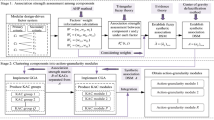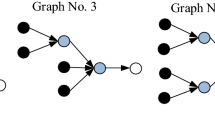Abstract
Modular product architecture is beneficial for the product maintenance, upgrade, components’ concurrent design through team work, and achieving the mass customization eventually. Recent researches tend to group elements into modules as a flat map, but this is inconsistent with the nested composition in product final assembly. Finding the hierarchical modular partition for elements of a product and obtaining its optimal granularity level are still necessary to ease the partition and combination for sub-design tasks. We use the design structure matrix (DSM) to represent the relationships among elements of a product. The hierarchical clustering functions such as pdist and linkage within MATLAB software are utilized to form the hierarchical dendrogram for DSM elements, and the modularity index Q is applied to assess the modular clustering results. The partitions are acquired by various distance threshold values in the vertical axis of the hierarchical dendrogram. The ‘cityblock’ and ‘average’ are found as preferred parameters for pdist and linkage functions, respectively, from loop test experiments. Combining the modularity formula in a research literature, a hierarchical modular architecture design methodology is proposed in this work to determine the optimal granularity level of a modular product and to provide solutions for designer selection. Case studies and comparisons in a benchmark problem and a concrete spraying machine illustrate the effectiveness and efficiency of the proposed method. It is characterized by being able to find stable modular partition results for both float and binary DSM elements and satisfying the recommended modular number rule simultaneously.










Similar content being viewed by others
Abbreviations
- DSM:
-
Design structure matrix
- FCM:
-
Fuzzy c-means algorithm
- GGA:
-
Group genetic algorithm
- HC:
-
Hierarchical clustering
- IC:
-
Integrative complexity
- LCA:
-
Life cycle assessment
- MDL:
-
Minimum description length
- MDS:
-
Multi-dimensional scaling
- MI:
-
Modularity index
- MSI:
-
Module strength indicator
- OMI:
-
Overall modularity index
- PC(c):
-
Partition coefficient c
- Q :
-
A modularity index named Q
- R-IGTA:
-
Revised algorithm on Image and Graphics Technologies and Applications
- Sil :
-
Silhouette index
- SMACOF:
-
Scaling by minimizing a convex function
- WCA:
-
Weighted combined algorithm
References
Deda T, Fujiwara E, Carneiro E (2018) Modular approach for control design of an autonomous two-wheeled inverted pendulum. J Braz Soc Mech Sci Eng 40:536–554
Gershenson JK, Prasad GJ, Zhang Y (2003) Product modularity: definitions and benefits. J Eng Des 14(3):295–313
Fan BB, Qi GN, Hu XM, Yu T (2015) A network methodology for structure-oriented modular product platform planning. J Intell Manuf 26(3):553–570
Colwel KC (2012) A look at Volkswagen’s new MQB platform for front-wheel-drive cars. https://www.caranddriver.com. Accessed 24 Feb 2012
Crenshaw A (2006) Modularity, the littoral combat ship and the future of the United States Navy. Report from Naval Strike Forum
Ginani LS, Motta JMST (2011) Theoretical and practical aspects of robot calibration with experimental verification. J Braz Soc Mech Sci Eng 33(1):15–21
Zhang WY, Tor SY, Britton GA (2006) Managing modularity in product family design with functional modeling. Int J Adv Manuf Technol 30(7–8):579–588
Xiao RB, Cheng XF, Cheng C, Chen WM (2012) New approach to product platform design based on axiomatic design and design relationship matrix. J Mech Eng 48(11):94–103 (in Chinese)
Li ZK, Cheng ZH, Feng YX, Yang JY (2013) An integrated method for flexible platform modular architecture design. J Eng Des 24(1):25–44
AlGeddawy T, ElMaraghy H (2013) Optimum granularity level of modular product design architecture. CIRP Ann Manuf Technol 62(1):151–154
Kashkoush M, ElMaraghy H (2017) Designing modular product architecture for optimal overall product modularity. J Eng Des 28(5):293–316
Li BM, Xie SQ (2015) Module partition for 3D CAD assembly models: a hierarchical clustering method based on component dependencies. Int J Prod Res 53(17):5224–5240
Moon SK, Kumara S, Simpson TW (2006) Data mining and fuzzy clustering to support product family design. In: Proceedings of IDETC/CIE 2006, ASME 2006 international design engineering technical conferences & computers and information in engineering conference, September 10–13, 2006, Philadelphia, Pennsylvania, USA
Li JZ, Zhang HC, Gonzalez MA, Yu S (2008) A multi-objective fuzzy graph approach for modular formulation considering end-of-life issues. Int J Prod Res 46(14):4011–4033
Whitfield R I, Smith J S and Duffy A B (2002) Identifying component modules. In: Seventh international conference on artificial intelligence in design, 15–17 July 2002, Cambridge, UK
Yu TL, Yassine AA, Goldberg DE (2007) An information theoretic method for developing modular architectures using genetic algorithms. Res Eng Des 18(2):91–109
Sinha K, Suh ES, Weck OD (2018) Integrative complexity: an alternative measure for system modularity. J Mech Des 140(5):051101-1-11
Rousseeuw PJ (1987) Silhouettes: a graphical aid to the interpretation and validation of cluster analysis. J Comput Appl Math 20(11):53–65
Tseng HE, Chang CC, Cheng CJ (2010) Disassembly-oriented assessment methodology for product modularity. Int J Prod Res 48(14):4297–4320
Morrison JR, Azhar M, Lee T, Suh H (2013) Axiomatic design for eco-design: eAD+. J Eng Des 24(10):711–737
Stone RB, Wood KL, Crawford RH (2000) A heuristic method for identifying modules for product architectures. Des Stud 21(1):5–31
Gao F, Xiao G, Simpson TW (2010) Identifying functional modules using generalized directed graphs: definition and application. Comput Ind 61(3):260–269
Otto K et al (2016) Global views on modular design research: linking alternative methods to support modular product modular product family concept development. J Mech Des 138(7):071101-1-16
Zhang M, Li GX et al (2016) A bottom-up method for module-based product platform development through mapping, clustering and matching analysis. J Central South Univ 23(3):623–636
Pandremenos J, Chryssolouris G (2011) A neural network approach for the development of modular product architectures. Int J Comput Integr Manuf 24(10):879–887
Yu SR, Yang QY et al (2011) Product modular design incorporating life cycle issues—group genetic algorithm (GGA) based method. J Clean Prod 19(9–10):1016–1032
Li Q, Efatmaneshnik M, Ryan M, Shoval S (2017) Product modular analysis with design structure matrix using a hybrid approach based on MDS and clustering. J Eng Des 28(6):433–456
Borjesson F, Holtta-Otto K (2014) A module generation algorithm for product architecture based on component interactions and strategic drivers. Res Eng Design 25(1):31–51
AlGeddawy T, ElMaraghy H (2013) Reactive design methodology for product family platforms, modularity and parts integration. CIRP J Manufact Sci Technol 6(1):34–43
Daie P, Li S (2016) Managing product variety through configuration of pre-assembled vanilla boxes using hierarchical clustering. Int J Prod Res 54(18):5468–5479
Daie P, Li S (2016) Hierarchical clustering for structuring supply chain network in case of product variety. J Manuf Syst 38:77–86
Wang PJ, Liu YX, Ong SK, Nee AYC (2014) Modular design of machine tools to facilitate design for disassembly and remanufacturing. In: 20st CIRP conference on life cycle engineering, Procedia CIRP, 2014, pp 443–448
Bishinoi M, Singh P (2016) Modularizing software systems using PSO optimized hierarchical clustering. In: 2016 international conference on computational technologies in information and communication technologies (ICCTICT), New Delhi, India, Mar 11–13
Mesa J, Maury H, Turizo J, Bula A (2014) A methodology to define a reconfigurable system architecture for a compact heat exchanger assembly machine. Int J Adv Manuf Technol 70(9–12):2199–2210
Bruse JL, Zuluaga MA et al (2017) Detecting clinically meaningful shape clusters in medical image data: metrics analysis for hierarchical clustering applied to healthy and pathological aortic arches. IEEE Trans Biomed Eng 64(10):2373–2383
Gucdemir H, Selim H (2015) Integrating multi-criteria decision making and clustering for business customer segmentation. Ind Manag Data Syst 115(6):1022–1040
Xu R, Wunsch D (2005) Survey of clustering algorithms. IEEE Trans Neural Networks 16(3):645–678
Yildirim P, Birant D (2017) K-linkage: a new agglomerative approach for hierarchical clustering. Adv Electr Comput Eng 17(4):77–88
The MathWorks, Inc. (2014). www.mathworks.cn/help. Accessed 11 June 2019
Ackermann MR, Bolmer J et al (2014) Analysis of agglomerative clustering. Algorithmica 69(1):184–215
Antonopoulos P, Nikolaidis N, Pitas I (2007) Hierarchical face clustering using sift image features. In: Proceedings of the 2007 IEEE symposium on computational intelligence in image and signal processing (CIISP 2007)
Subbalakshmi C, Krishna GR et al (2015) A method to find optimum number of cluster based on fuzzy Silhouette on dynamic data set. Procedia Comput Sci 46:346–353
Thebeau RE (2001) Knowledge management of system interfaces and interactions for product development processes. Master Thesis in MIT, Boston: Massachusetts Institute of Technology
Li ZK, Pehlken A, Qian HT, Hong ZX (2016) A systematic adaptable platform architecture design methodology for early product development. J Eng Des 27(1–3):93–117
Tang CH, Tsai MF et al (2014) Shortest-linkage-based parallel hierarchical clustering on main-belt moving objects of the solar system. Future Gener Comput Syst Int J ESci 34:26–46
Acknowledgements
The support for this work by Fundamental Research Funds for the Central Universities of China (2017XKQY040) and Priority Academic Program Development of Jiangsu Education Department of China (PAPD) is gratefully acknowledged. We thank Dr Shuzhe Tang at China University of Mining & Technology for improving the context and also for the constructive comments of the anonymous reviewers.
Author information
Authors and Affiliations
Corresponding author
Additional information
Technical Editor: Dr. Fernando Antonio Forcellini.
Publisher's Note
Springer Nature remains neutral with regard to jurisdictional claims in published maps and institutional affiliations.
Rights and permissions
About this article
Cite this article
Li, Zk., Wang, S. & Yin, Ww. Determining optimal granularity level of modular product with hierarchical clustering and modularity assessment. J Braz. Soc. Mech. Sci. Eng. 41, 342 (2019). https://doi.org/10.1007/s40430-019-1848-y
Received:
Accepted:
Published:
DOI: https://doi.org/10.1007/s40430-019-1848-y




